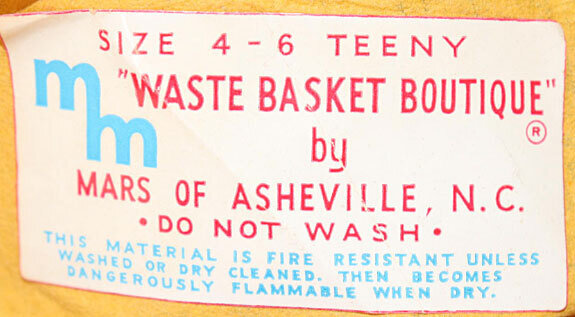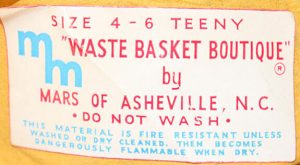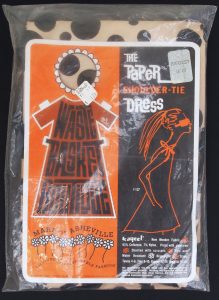Mars of Asheville had already developed a line of paper dresses that had not sold well when, in 1966, the Scott Paper Company began selling two styles of inexpensive paper dresses as a gimmick to promote the purchase of more disposable paper products. By the end of 1966, Scott had received nearly half a million orders for the two styles. A fad was born, and Mars was ready to make the most of this opportunity.
Bob Bayer, the son-in-law of the founders of hosiery producer Mars Manufacturing, worked on developing a prototype for disposable paper underwear for military use in the early 1960s, collaborating with Kimberly Clark Corporation and J.P. Stevens. When the underwear didn’t hold up as hoped, Bayer and Ron Bard, another Mars executive, shifted to creating fashionable items. Bob’s wife Audie, who was the daughter of Mars’s founder, designed the prints (which were often pretty wild) and the styles.
Mars of Asheville quickly became the leading paper dress producer as demand skyrocketed. Mars sold these dresses under the name Waste Basket Boutique. At its peak, 80,000 Waste Basket Boutique garments were shipped each week.
From A-line shifts, the company added bell-bottom jumpsuits, vests for men, dresses for girls, coats, ponchos, evening gowns—and even swimsuits! Also popular were dresses for specific businesses.
In the fall of 1966, Mars of Asheville offered a white dress that came with a watercolor paint set for $6. The package read “Be Creative! Paint your Dress! Paint your own ‘Happening’! Be autographed!” The company hired Andy Warhol to design one of these blank canvases, and he stenciled ‘fragile’ onto the dress while a model wore it, and signed the dress ‘Dali’. The dress is now in the collection of the Brooklyn Museum.
A Waste Basket Boutique dress covered with a telephone yellow pages design was marketed with the line “Wear the Yellow Pages Out for $1” in a full-page ad for Parade magazine in October 1968. Two days after the ad ran, Mars received 5,000 orders—within three days they received 75,000 orders.
By the late 1960s, with the environmental movement growing, the concept of disposable fashion declined, and the fad ended. Mars Manufacturing shifted production to disposable industrial and surgical clothing.
Written by denisebrain
See also
Paper Dresses by Jonathan Walford



